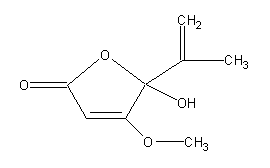ID 2: 117
Toxin: y
Trivial name:
Penicillic acid (6CI); 3-Methoxy-5-methyl-4-oxo-2,5-hexadienoic acid; NSC 402844; γ-keto-β-Methoxy-δ-methylene-Δα-hexenoic acid
Systematic name:
2,5-Hexadienoic acid, 3-methoxy-5-methyl-4-oxo-
Molecular formulae:
C8H10O4
Molecular weight: 170.16
Chemical abstract number: 90-65-3
Literature reference:
References URL:
Aspergillus Species known to produce this metabolite:
Toxicity:
mouse LD50 intraperitoneal 90mg/kg (90mg/kg) Toxicology and Applied Pharmacology. Vol. 52, Pg. 1, 1980.
Link to PubMed
mouse LD50 intravenous 250mg/kg (250mg/kg) Journal of Pharmacology and Experimental Therapeutics. Vol. 88, Pg. 119, 1946.
mouse LD50 oral 600mg/kg (600mg/kg) Journal of Pharmacology and Experimental Therapeutics. Vol. 88, Pg. 119, 1946.
mouse LD50 subcutaneous 100mg/kg (100mg/kg) “Merck Index; an Encyclopedia of Chemicals, Drugs, and Biologicals”, 11th ed., Rahway, NJ 07065, Merck & Co., Inc. 1989Vol. 11, Pg. 1122, 1989.
mouse LDLo unreported 280mg/kg (280mg/kg) British Journal of Cancer. Vol. 15, Pg. 85, 1961.
Link to PubMed
rat LD50 intraperitoneal 90mg/kg (90mg/kg) LIVER: EFFECTS: OTHER CHANGES Journal of Toxicology and Environmental Health. Vol. 7, Pg. 169, 1981.
Link to PubMed
Structure image:

Date uploaded: 2005-12-14 00:00:00
Mycotoxin & Metabolites
-
Metabolite
Produced by (species)
Molecular weight
References
-
399.0
428.5
445.5
443.5
321.5
138.1
264.3
138.1
182.2
Mycotoxin & Metabolite database
Aspergillus species produce a large number of secondary metabolites, sometimes referred to as extrolites. We attempt to list them all here and we also collect published papers.
Search Metabolite papers here
